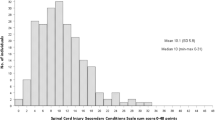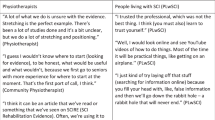Abstract
Study design:
Clinometrics study.
Objective:
To devise a way of capturing the unbiased perspectives of people living with a spinal cord injury (SCI) in assessments of mobility.
Setting:
SCI unit and community.
Methods:
Three groups of raters used the Global Impression of Change Scale (GICS) to rate change in mobility of a cohort of patients with a recent SCI. The three groups of raters were as follows: 10 people with a recent SCI, 10 people with an established SCI and 10 physiotherapists. The ratings were done after viewing 51 pairs of videos depicting one of three motor tasks: sitting unsupported, transferring and walking. Each pair of videos showed the same person performing the same motor task on two occasions. The videos were taken between 1 h and 5 months apart and presented side by side, randomly left or right, on the screen. Raters were asked to score the amount of change in performance between the two videos on a 7-point Global Impression of Change Scale (GICS). Intra-rater reliability for the three motor tasks and three groups of raters was determined using intra-class correlation coefficients.
Results:
People with an SCI were reliable at rating change in patients’ abilities to transfer and walk with ICC’s ranging from 0.66 to 0.81 (95% Confidence interval bounds ranging from 0.51 to 0.94). Physiotherapists were consistently but only marginally more reliable at rating than people with an SCI.
Conclusions:
Videos and the GICS may provide a way of using the unbiased perspectives of people living with spinal cord injury in assessments of mobility.
Similar content being viewed by others
Log in or create a free account to read this content
Gain free access to this article, as well as selected content from this journal and more on nature.com
or
References
Graves DE . The construct validity and explanatory power of the AISA Motor Score and the FIM: implications for theoretical models of spinal cord injury. Top Spinal Cord Inj Rehabil 2005; 10: 65–74.
Ditunno JF Jr, Ditunno PL, Scivoletto G, Patrick M, Dijkers M, Barbeau H et al. The Walking Index for Spinal Cord Injury (WISCI/WISCI II): nature, metric properties, use and misuse. Spinal Cord 2013; 51: 346–355.
Campbell J, Kendall M . Investigating the suitability of the clinical outcome variables scale (COVS) as a mobility outcome measure in spinal cord injury rehabilitation. Physiother Can 2003; 55: 135–144.
Schneider LS, Olin JT . Clinical global impressions of change. Clinical global impressions in Alzheimer's clinical trials. Int Psychogeriatr 1996; 8: 277–288.
Studenski S, Hayes RP, Leibowitz RQ, Bode R, Lavery L, Walston J et al. Clinical Global Impression of Change in physical frailty: development of a measure based on clinical judgment. J Am Geriatr Soc 2004; 52: 1560–1566.
Tannenbaum C, Brouillette J, Corcos J . Rating improvements in urinary incontinence: do patients and their physicians agree? Age Ageing 2008; 37: 379–383.
Spielmans GI, McFall JP . A comparative meta-analysis of Clinical Global Impressions change in antidepressant trials. J Nerv Ment Dis 2006; 194: 845–852.
Farrar JT, Young JP Jr, LaMoreaux L, Werth JL, Poole RM . Clinical importance of changes in chronic pain intensity measured on an 11-point numerical pain rating scale. Pain 2001; 94: 149–158.
Wiles CM, Newcombe RG, Fuller KJ, Shaw S, Furnival-Doran J, Pickersgill TP et al. Controlled randomised crossover trial of the effects of physiotherapy on mobility in chronic multiple sclerosis. J Neurol Neurosurg Psychiatry 2001; 70: 174–179.
Pooyania S, Ethans K, Szturm T, Casey A, Perry D . A randomized, double-blinded, crossover pilot study assessing the effect of nabilone on spasticity in persons with spinal cord injury. Arch Phys Med Rehabil 2010; 91: 703–707.
Siddall PJ, Cousins MJ, Otte A, Griesing T, Chambers R, Murphy TK . Pregabalin in central neuropathic pain associated with spinal cord injury: a placebo-controlled trial. Neurology 2006; 67: 1792–1800.
Soler MD, Kumru H, Pelayo R, Vidal J, Tormos JM, Fregni F et al. Effectiveness of transcranial direct current stimulation and visual illusion on neuropathic pain in spinal cord injury. Brain 2010; 133: 2565–2577.
Harvey L, Folpp H, Denis S, Barratt D, Quirk R, Allison G et al. Clinicians’ and patients’ impressions of change in motor performance as potential outcome measures for clinical trials. Spinal Cord 2011; 49: 30–35.
Wiles CM, Newcombe RG, Fuller KJ, Jones A, Price M . Use of videotape to assess mobility in a controlled randomized crossover trial of physiotherapy in chronic multiple sclerosis. Clin Rehabil 2003; 17: 256–263.
Quinn J, Moore M, Benson DF, Clark CM, Doody R, Jagust W et al. A videotaped CIBIC for dementia patients: validity and reliability in a simulated clinical trial. Neurology 2002; 58: 433–437.
Norman GR, Stratford P, Regehr G . Methodological problems in the retrospective computation of responsiveness to change: the lesson of Cronbach. J Clin Epidemiol 1997; 50: 869–879.
Fleiss J . The Design and Analysis of Clinical Experiments. Wiley: New York. 1986.
Anderson B, Lygren H, Magnussen LH, Eide GE, Strand LI . What functional aspects explain patients' impression of change after rehabilitation for long-lasting low back pain? Physiother Res Int, (e-pub ahead of print 30 may 2013; doi:10.1002/i.1548).
Ferreira ML, Herbert RD, Ferreira PH, Latimer J, Ostelo RW, Nascimento DP et al. A critical review of methods used to determine the smallest worthwhile effect of interventions for low back pain. J Clin Epidemiol 2012; 65: 253–261.
Acknowledgements
This study was funded by the Motor Accidents Authority of NSW and the Rehabilitation and Disability Research Grant Scheme of the Royal Rehabilitation Centre Sydney. We are grateful for the assistance of past patients of the Royal Rehabilitation Centre Sydney, and the Australian and New Zealand physiotherapists who rated the videos (names are withheld in accordance with conditions of Ethical Approval). We also acknowledge the helpful feedback provided by Marsha Ben and Ian Cameron on the manuscript.
Author information
Authors and Affiliations
Corresponding author
Ethics declarations
Competing interests
The authors declare no conflict of interest.
Rights and permissions
About this article
Cite this article
Booth, H., Harvey, L., Denis, S. et al. Using the unbiased perspectives of people living with a spinal cord injury in assessments of mobility. Spinal Cord 51, 843–846 (2013). https://doi.org/10.1038/sc.2013.100
Received:
Revised:
Accepted:
Published:
Issue date:
DOI: https://doi.org/10.1038/sc.2013.100



